Table of Contents
Essential Philodendron Birkin Care Guide: Growing and Caring for the Stunning Birkin Plant
Philodendron birkin is a beautiful houseplant that has become very popular among plant lovers. It has deep green leaves with white stripes that create a stunning contrast. Philodendron birkin is a tropical plant that is easy to care for and can thrive indoors with minimal maintenance. In this article, we will provide you with a complete guide on how to care for your philodendron birkin and keep it healthy and happy.
All About Philodendron Birkin Plant Care: Birkin Plant Overview
Philodendron birkin is a relatively new cultivar of philodendron, which is a genus of plants that belong to the family Araceae. Philodendrons are native to tropical regions of the Americas and are known for their large and diverse foliage. There are over 450 species of philodendrons, some of which are climbers, while others are self-heading, meaning they grow upright without the need of support.
Philodendron birkin is a self-heading philodendron that grows up to 2 feet tall and wide. It has glossy, oval-shaped leaves that are dark green with white or cream-colored stripes. The stripes vary in width and pattern, giving each leaf a unique look. The leaves can grow up to 10 inches long and 5 inches wide, and they emerge from a central stem.
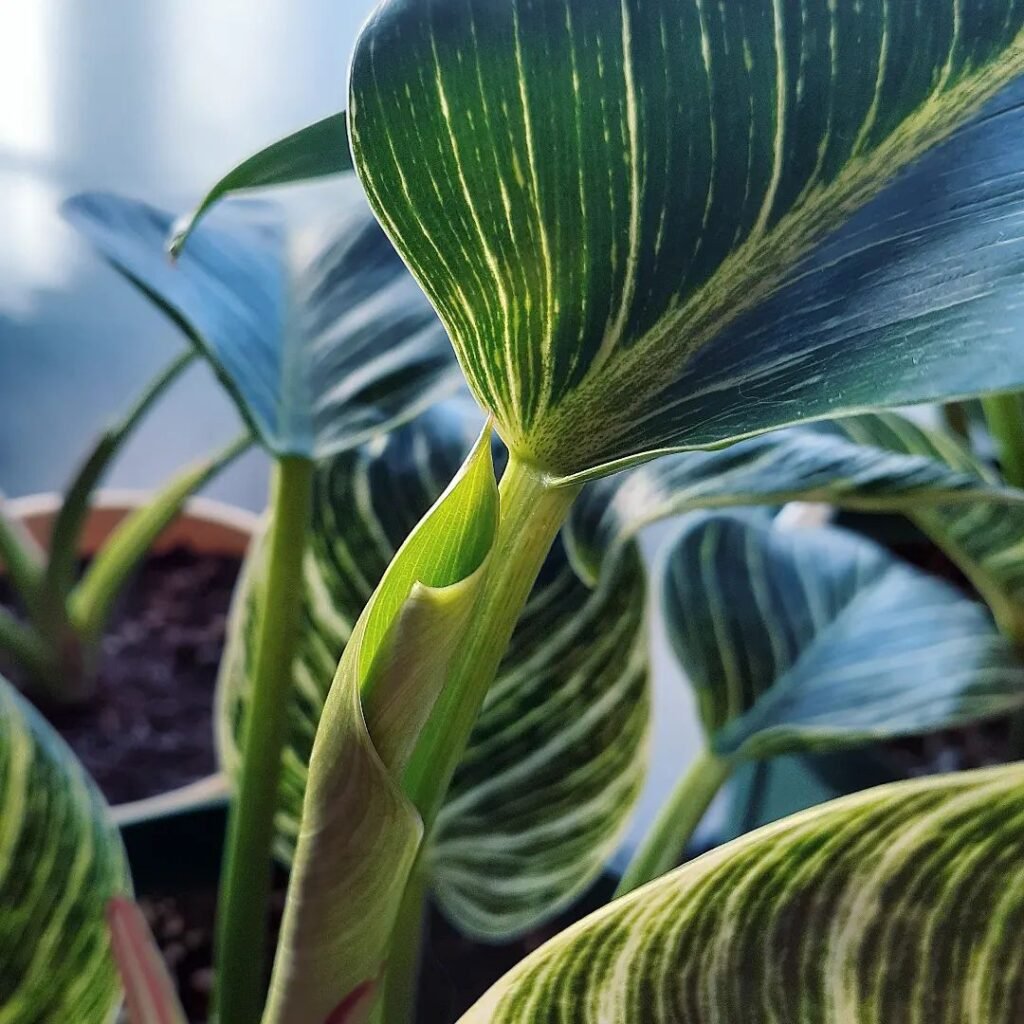
Philodendron birkin is a fast-growing plant that can produce new leaves every week or two, depending on the growing conditions. The new leaves are usually light green and gradually darken as they mature. The older leaves may lose some of their variegation and turn completely green over time. This is normal and does not indicate any problem with the plant.
The Origin of Philodendron Birkin
| Aspect | Information |
|---|---|
| Discovery Year | 2016 |
| Location of Discovery | Thailand |
| Cultivation Method | Tissue culture in a nursery |
| Believed Origin | Mutation of philodendron rojo congo, a species with red stems and green leaves |
| Name and Alias | – Named after the Birkin bag by Hermes, denoting rarity and elegance. – Also known as philodendron white stripe or philodendron white measure |
| Official Cultivar Status | Not registered as an official cultivar by the International Aroid Society, subject to potential name changes in the future if found identical or similar to another philodendron. |
Unique Features of Philodendron Birkin
Philodendron birkin has several unique features that make it stand out from other philodendrons. Some of these features are:
- Variegated foliage: Philodendron birkin has striking white or cream-colored stripes on its dark green leaves, creating a stunning contrast. The variegation is caused by a lack of chlorophyll in some parts of the leaf, which results in less green pigment. The variegation can vary from leaf to leaf, and even within the same leaf, giving each plant a distinctive look.
- Compact growth: Philodendron birkin is a self-heading philodendron that grows upright without the need of support. It has a compact and bushy growth habit that makes it ideal for small spaces and containers. It can grow up to 2 feet tall and wide, but it can be kept smaller by pruning or repotting.
- Easy care: Philodendron birkin is an easy-to-care-for plant that can adapt to various indoor environments. It does not require much attention or maintenance, as long as it receives adequate light, water, and fertilizer. It can tolerate low light and dry air, but it prefers bright indirect light and high humidity for optimal growth.
- Air purifying: Philodendron birkin is an air-purifying plant that can remove harmful toxins from the air, such as formaldehyde, benzene, and xylene. These toxins are commonly found in household products, such as paints, cleaners, and plastics. By having a philodendron birkin in your home or office, you can improve the quality of the air you breathe and reduce the risk of respiratory problems.
A Closer Look at Philodendron Birkin Plant Care
Philodendron birkin is an easy-to-care-for plant that does not require much attention or maintenance. However, there are some basic guidelines that you should follow to ensure that your birkin plant stays healthy and happy. Here are some of the most important aspects of birkin plant care that you should know:
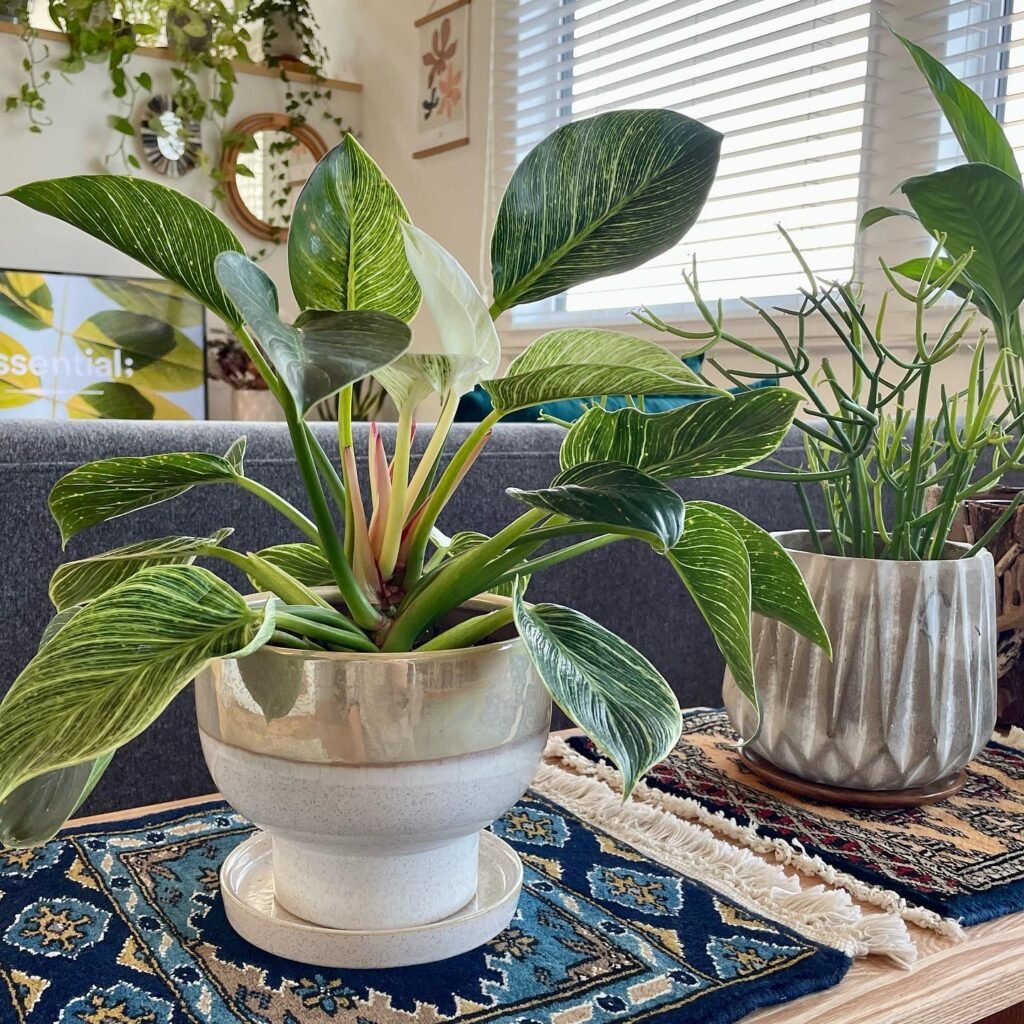
Soil Type Best Suited for Philodendron Birkin Care
- Philodendron birkin is not very picky about soil type as long as it’s well-draining and rich in organic matter.
- Suggested potting mix: equal parts peat moss, perlite, and compost.
- Additional options include bark, charcoal, or coco coir to improve aeration and drainage.
- pH level: Slightly acidic to neutral, between 5.5 and 7.0. Adjust using vinegar, lemon juice, sulfur to lower pH, or lime, wood ash, or baking soda to raise pH.
- Avoid heavy, compacted, or waterlogged soil to prevent root rot.
- Avoid sandy, alkaline, or salty soil to prevent nutrient deficiencies and leaf burn.
Criteria for Watering Your Philodendron Birkin Care
- Water thoroughly until it drains from the pot (soak and dry method).
- Frequency varies based on factors like pot size, soil type, temperature, humidity, and season.
- General guideline: once a week in spring and summer, once every two weeks in fall and winter.
- Check soil moisture with finger, moisture meter, or wooden skewer.
- Use lukewarm, dechlorinated water and avoid cold or hot water.
- Water in the morning or early afternoon.
- Water evenly and thoroughly, avoid watering from above or spraying leaves.
- Drain excess water from the saucer or tray.
Light Requirements: How Much Sunlight Does Birkin Plant Need?
- Bright indirect light is ideal. Can tolerate low light but growth may slow, and coloration may fade.
- Avoid direct sunlight, which can scorch or bleach leaves.
- Place near a window with filtered or diffused light. Use curtains or blinds for protection.
- Rotate the plant regularly and clean its leaves to enhance photosynthesis.
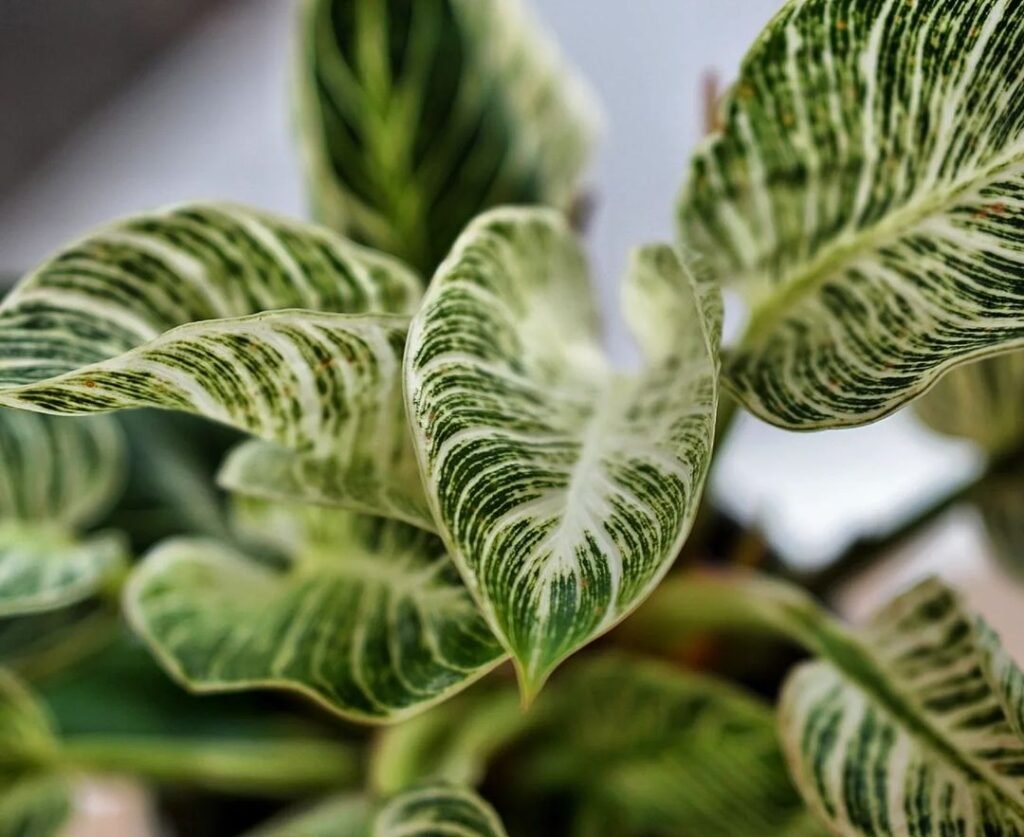
Temperature and Humidity: The Ideal Environment for Philodendron Birkin Care
Philodendron birkin prefers warm and humid conditions to thrive. It can tolerate a wide range of temperatures, but it does not like sudden changes or extremes. The ideal temperature range for your philodendron birkin is between 65°F and 85°F (18°C and 29°C). You should avoid exposing your plant to temperatures below 50°F (10°C) or above 95°F (35°C), as this can cause stress or damage to your plant.
Philodendron birkin also loves high humidity levels, as this mimics its natural habitat in the tropical rainforest. The ideal humidity level for your philodendron birkin is between 60% and 80%. You can increase the humidity around your plant by using a humidifier, a pebble tray, a misting bottle, or grouping it with other plants. You should avoid placing your plant near sources of dry air, such as heaters, air conditioners, or vents.
You should monitor the temperature and humidity levels around your philodendron birkin regularly and adjust them accordingly. You can use a thermometer and a hygrometer to measure these levels more accurately and should also keep your plant away from drafts, windows, or doors that can cause fluctuations in temperature or humidity.
Fertilizing Your Philodendron Birkin: What and When?
- Use balanced liquid fertilizer with equal N-P-K (e.g., 10-10-10 or 20-20-20) or a slow-release granular fertilizer for houseplants.
- Fertilize monthly during the growing season (spring and summer). Dilute to half or quarter strength.
- Water before and after fertilizing to prevent root burn.
- Stop fertilizing in fall and winter when the plant is dormant or slow-growing. Reduce fertilization if over-fertilization symptoms appear.
- Avoid excessive nitrogen to prevent excessive growth and reduced variegation.
Additional Philodendron Birkin Care Tips
Besides the basic aspects of birkin plant care that we have discussed so far, there are some additional tips that you can follow to ensure that your philodendron birkin stays healthy and happy. Here are some of them:
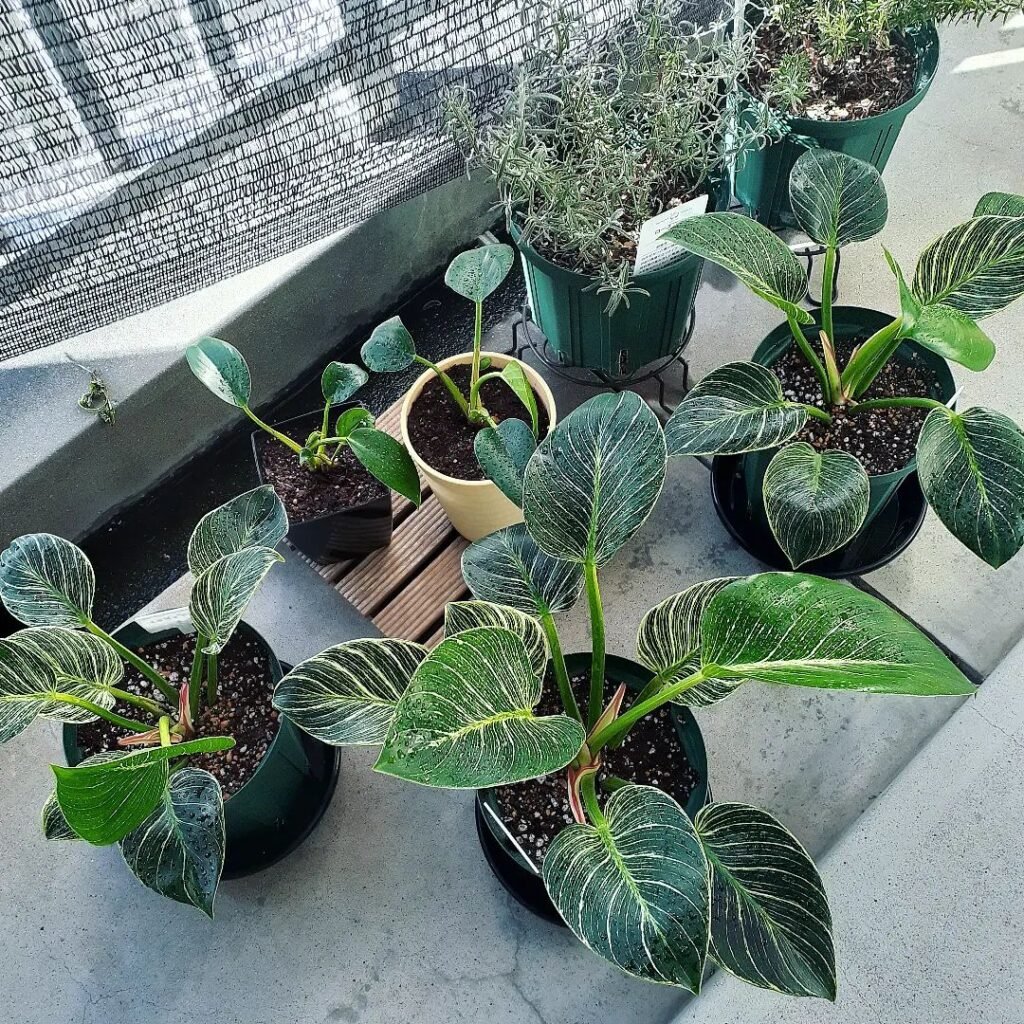
Pruning Your Philodendron Birkin Plant
Pruning your philodendron birkin plant is not necessary, but it can help you shape your plant, remove dead or damaged leaves, and promote new growth. You can prune your philodendron birkin anytime of the year, but it is best to do it in spring or summer.
Use clean and sharp scissors or pruners to cut off any unwanted or unhealthy leaves at the base of the stem. Avoid cutting more than one-third of the plant at a time, as this can stress or shock your plant.
Potting and Repotting Guidelines for Birkin Plant
Potting and repotting your birkin plant is important to provide it with fresh soil, adequate space, and proper drainage. Pot or repot your philodendron birkin every one or two years, depending on how fast it grows and should choose a pot that is slightly larger than the previous one, with drainage holes at the bottom.
Use a well-draining and rich potting mix for your philodendron birkin, as we have discussed earlier. Gently remove your plant from its old pot and shake off any excess soil from its roots. Inspect the roots for any signs of rot or disease and trim off any damaged or dead roots. Place your plant in the center of the new pot and fill it with fresh soil until it covers the roots and water your plant well after potting or repotting and place it in a bright location.
Philodendron Birkin Propagation: Multiplying Your Plant
Propagation is a process of creating new plants from existing ones. Propagating your philodendron birkin is a fun and easy way to multiply your plant collection or share it with your friends and family. There are two main methods of propagating your philodendron birkin: stem cuttings and division.
Step by Step Guide to Philodendron Birkin Propagation
Here is a step by step guide to propagating your philodendron birkin by stem cuttings and division:
- Stem Cuttings: Stem cuttings are the most common and simple method of propagating your philodendron birkin. You can take stem cuttings from your philodendron birkin anytime of the year, but it is best to do it in spring or summer, when the plant is actively growing. Here are the steps to follow:
- Choose a healthy and mature stem from your philodendron birkin that has at least one or two leaves and a node. A node is a swollen part of the stem where new roots and leaves can emerge.
- Use clean and sharp scissors or pruners to cut off the stem about an inch below the node. You can make multiple cuttings from the same stem, as long as each cutting has a node and a leaf.
- Remove any lower leaves from the cutting, leaving only one or two leaves at the top. This will reduce water loss and encourage root growth.
- Dip the cut end of the stem in some rooting hormone powder or gel, if you have any. This will help speed up the rooting process and prevent infections.
- Place the cutting in a glass of water or a small pot of moist soil. If you use water, make sure that only the cut end of the stem is submerged, and not the leaves. If you use soil, make sure that the node is buried in the soil, and not the leaves.
- Place the cutting in a bright location, but away from direct sunlight. Keep the water or soil moist, but not soggy. Change the water every few days or add some liquid fertilizer to prevent algae growth and provide nutrients.
- Wait for roots to develop, which can take anywhere from two to six weeks, depending on the temperature and humidity. You can check for roots by gently tugging on the cutting or looking through the glass. The roots should be at least an inch long before you transplant the cutting.
- Transplant the cutting into a pot with fresh potting mix, following the same guidelines as potting or repotting your philodendron birkin. Water your new plant well and place it in a bright location.

- Division: Division is another method of propagating your philodendron birkin that involves separating your plant into smaller parts. You can divide your philodendron birkin every one or two years, when it becomes too large or crowded for its pot. You should divide your philodendron birkin in spring or summer, when it is actively growing. Here are the steps to follow:
- Remove your philodendron birkin from its pot and shake off any excess soil from its roots. You can also rinse the roots with water to remove any dirt or debris.
- Inspect the root ball and look for natural divisions or sections that have their own stems and leaves. You can also use a knife or scissors to cut through the root ball if necessary.
- Gently pull apart or cut off each division, making sure that each one has enough roots, stems, and leaves to survive on its own. You can make as many divisions as you want, depending on how big your plant is and how many new plants you want to create.
- Pot each division into a new pot with fresh potting mix, following the same guidelines as potting or repotting your philodendron birkin. Water each new plant well and place them in a bright location.
Common Problems with Philodendron Birkin Care and Their Solutions
Philodendron birkin is generally a healthy and resilient plant that does not suffer from many problems. However, there are some common issues that may affect your philodendron birkin and cause it to look unhealthy or unhappy. Here are some of them and how to solve them:
Understanding Philodendron Birkin Pests and Diseases
Philodendron birkin is not very prone to pests and diseases, but it can still be attacked by some common houseplant enemies, such as mealybugs, spider mites, scale insects, aphids, thrips, fungus gnats, root rot, leaf spot, powdery mildew, etc.
These pests and diseases can cause various symptoms on your philodendron birkin, such as yellowing, wilting, curling, drooping, browning, spotting, discoloration, distortion, holes, webbing, sticky residue, etc.
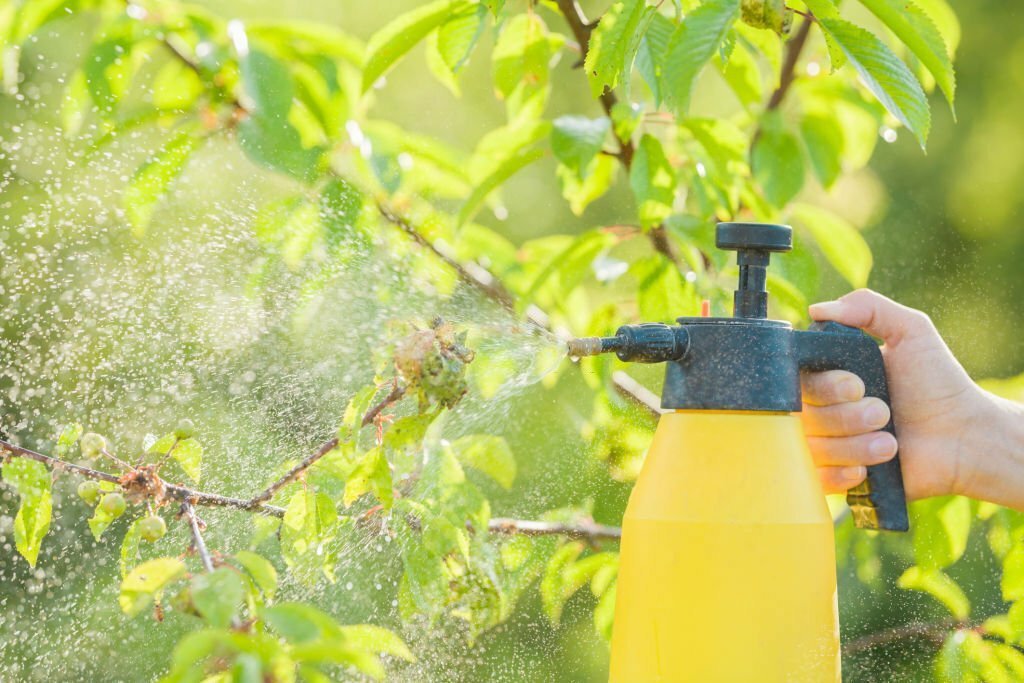
The best way to prevent these pests and diseases from affecting your philodendron birkin is to provide it with the optimal growing conditions that we have discussed earlier. You should also inspect your plant regularly for any signs of infestation or infection and act quickly if you notice any.
| Pest/Disease | Description | Treatment | Prevention |
|---|---|---|---|
| Mealybugs | Small, white, fluffy insects that sap from leaves, produce honeydew, and can attract ants and fungal growth. | – Wipe off with rubbing alcohol or insecticidal soap on a cotton swab or brush. – Spray with neem oil or horticultural oil. Repeat weekly until clear. | Maintain plant hygiene. Isolate new plants. |
| Spider Mites | Tiny, red or brown spiders that create webbing, cause color loss, and leaf damage. | – Wash off with a strong jet of water. – Spray with miticide or homemade solution (water, dish soap, and vegetable oil). Repeat every few days until clear. | Increase humidity and regularly clean leaves. |
| Scale Insects | Small, brown or gray insects with hard shells that sap from stems and leaves, producing honeydew. | – Scrape off with a toothpick or knife. – Wipe off with rubbing alcohol or insecticidal soap on a cotton swab or brush. – Spray with neem oil or horticultural oil. Repeat weekly until clear. | Inspect new plants before introducing them. |
| Aphids | Small, green or black insects that cluster on new growth, causing leaf issues and producing honeydew. | – Wash off with a strong jet of water. – Spray with insecticidal soap or homemade solution (water, dish soap, and vinegar). – Introduce beneficial insects (e.g., ladybugs or lacewings). Repeat treatment every few days until clear. | Use yellow sticky traps and avoid overfertilizing. |
| Thrips | Small, black or yellow insects that cause leaf and flower damage, as well as transmit viral diseases. | – Use sticky traps or a vacuum cleaner to capture them. – Spray with insecticidal soap or neem oil. Repeat weekly until clear. | Avoid introducing infested plants and maintain overall plant health. |
| Fungus Gnats | Small, black flies that lay eggs in moist soil, with larvae feeding on organic matter and roots. | – Use yellow sticky traps or a bowl of vinegar to trap adult gnats. – Spray with bacillus thuringiensis or hydrogen peroxide to kill larvae. Ensure soil dries between waterings. Repeat treatment weekly until clear. | Allow soil to dry between waterings and maintain proper sanitation. |
| Root Rot | Fungal disease affecting roots, caused by overwatering, poor drainage, or contaminated soil. | – Remove the plant from the pot, cut off infected roots, wash remaining roots with water and disinfect with fungicide or bleach. – Repot in fresh, sterile potting mix. Water sparingly. Improve drainage and ventilation. Prevent overwatering. | Use well-draining soil and pots with drainage holes. |
| Leaf Spot | Fungal or bacterial disease causing brown or black spots with yellow halos on leaves due to high humidity or poor air circulation. | – Remove infected leaves and dispose properly. – Spray with fungicide or copper solution. Improve air circulation and prevent leaf wetting. Repeat treatment as needed. | Avoid overhead watering and maintain proper spacing between plants. |
| Powdery Mildew | Fungal disease leading to white or gray powdery patches on leaves, typically due to low light, high humidity, or poor air circulation. | – Remove affected leaves and dispose of them. – Spray with fungicide or baking soda solution. Increase light and air circulation. Maintain lower humidity. Repeat treatment as needed. | Maintain good spacing between plants and prune for air circulation. Ensure proper lighting conditions. |
Dealing with Common Philodendron Birkin Problems: Curling Leaves, Yellow Leaves, etc.
Besides pests and diseases, there are some other common problems that may affect your philodendron birkin and cause it to look unhealthy or unhappy. Here are some of them and how to deal with them:
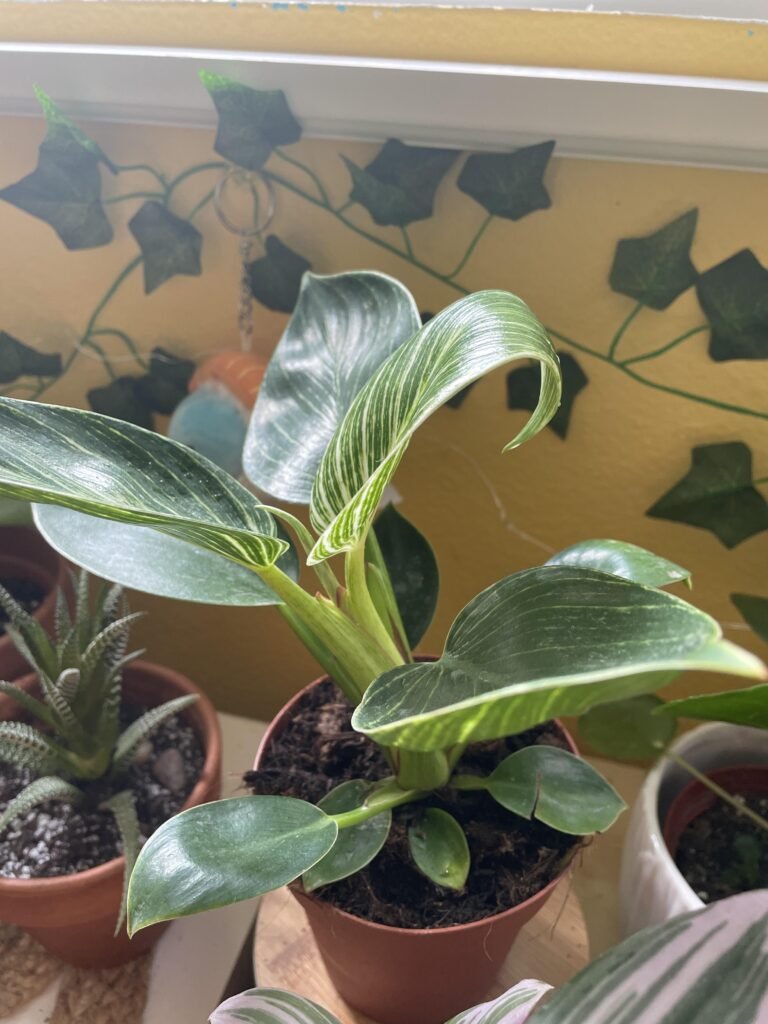
- Curling Leaves: Curling leaves are usually a sign of underwatering, low humidity, or cold stress. To fix this problem, you should water your philodendron birkin more frequently and deeply, increase the humidity around it, and keep it away from cold drafts or windows.
- Yellow Leaves: Yellow leaves are usually a sign of overwatering, nutrient deficiency, or root rot. To fix this problem, you should water your philodendron birkin less frequently and let the soil dry out between waterings, fertilize your philodendron birkin regularly during its growing season, and check its roots for any signs of rot or disease.
- Brown Tips: Brown tips are usually a sign of salt buildup, low humidity, or fertilizer burn. To fix this problem, you should flush out the excess salts from the soil by watering your philodendron birkin thoroughly until the water drains out of the bottom of the pot, increase the humidity around it, and dilute the fertilizer to half or quarter strength before applying it.
- Drooping Leaves: Drooping leaves are usually a sign of overwatering, underwatering, root rot, or shock. To fix this problem, you should adjust your watering schedule according to the moisture level of the soil and the season, check your plant’s roots for any signs of rot or disease, and move your plant to a more suitable location if it has been exposed to sudden changes in temperature, light, or humidity.
- Loss of Variegation: Loss of variegation is usually a sign of low light, high nitrogen, or genetic instability. To fix this problem, you should provide your philodendron birkin with more bright indirect light, use a balanced fertilizer that is not too high in nitrogen, and accept that some plants may lose their variegation over time due to natural variation.
Frequently Asked Questions about Philodendron Birkin Care
How often should I water my philodendron birkin?
You should water your philodendron birkin once a week in spring and summer, and once every two weeks in fall and winter. However, you should always check the moisture level of the soil before watering your plant and adjust accordingly. Use the “soak and dry” method to water your plant thoroughly and let the soil dry out slightly before watering again.
How much light does my philodendron birkin need?
Your philodendron birkin needs bright indirect light to grow well and maintain its variegation. It can tolerate low light conditions, but it will grow slower and lose some of its coloration. It cannot tolerate direct sunlight, as this can scorch or bleach its leaves. The ideal location for your philodendron birkin is near a window that receives filtered or diffused light throughout the day.
How do I propagate my philodendron birkin?
You can propagate your philodendron birkin by stem cuttings or division. Take stem cuttings from your philodendron birkin anytime of the year, but it is best to do it in spring or summer. You can divide your philodendron birkin every one or two years, when it becomes too large or crowded for its pot.
Is my philodendron birkin toxic?
Yes, your philodendron birkin is toxic to humans and animals if ingested. It contains calcium oxalate crystals that can cause irritation, swelling, burning, or difficulty breathing in the mouth and throat. You should keep your philodendron birkin away from children and pets and seek medical attention if any symptoms occur.
Why is my philodendron birkin losing its variegation?
Your philodendron birkin may lose its variegation due to low light, high nitrogen, or genetic instability. To prevent this from happening, you should provide your philodendron birkin with more bright indirect light, use a balanced fertilizer that is not too high in nitrogen, and accept that some plants may lose their variegation over time due to natural variation.
Key Takeaways | Philodendron Birkin Care
- Use a well-draining and rich potting mix that consists of peat moss, perlite, and compost, in equal parts.
- Water your philodendron birkin once a week in spring and summer, and once every two weeks in fall and winter. Use the “soak and dry” method to water your plant thoroughly and let the soil dry out slightly before watering again.
- Provide your philodendron birkin with bright indirect light, but avoid direct sunlight. Rotate your plant every few weeks to ensure even growth and variegation.
- Keep your philodendron birkin in a warm and humid environment, between 65°F and 85°F (18°C and 29°C) and 60% and 80% humidity. Avoid sudden changes or extremes in temperature or humidity.
- Fertilize your philodendron birkin once a month in spring and summer, with a balanced liquid fertilizer diluted to half or quarter strength. Stop fertilizing in fall and winter.
- Prune your philodendron birkin as needed to shape it, remove dead or damaged leaves, and promote new growth. Use clean and sharp scissors or pruners to cut off any unwanted or unhealthy leaves at the base of the stem.
- Pot or repot your philodendron birkin every one or two years, depending on how fast it grows. Choose a pot that is slightly larger than the previous one, with drainage holes at the bottom. Gently remove your plant from its old pot and shake off any excess soil from its roots. Inspect the roots for any signs of rot or disease and trim off any damaged or dead roots. Place your plant in the center of the new pot and fill it with fresh soil until it covers the roots. Water your plant well after potting or repotting and place it in a bright location.
- Propagate your philodendron birkin by stem cuttings or division. Take stem cuttings from your philodendron birkin anytime of the year, but preferably in spring or summer. Divide your philodendron birkin every one or two years, when it becomes too large or crowded for its pot. Pot each cutting or division into a new pot with fresh potting mix and water them well.
- Protect your philodendron birkin from pests and diseases, such as mealybugs, spider mites, scale insects, aphids, thrips, fungus gnats, root rot, leaf spot, powdery mildew, etc. Inspect your plant regularly for any signs of infestation or infection and act quickly if you notice any. Use natural or chemical remedies to get rid of them and prevent them from coming back.
- Deal with common problems that may affect your philodendron birkin, such as curling leaves, yellow leaves, brown tips, drooping leaves, loss of variegation, etc. Identify the cause of the problem and fix it accordingly.
We hope that this article has helped you learn more about philodendron birkin care and inspired you to grow this beautiful plant in your home or office. If you have any questions or comments about this article, please feel free to leave them below. Happy growing!



